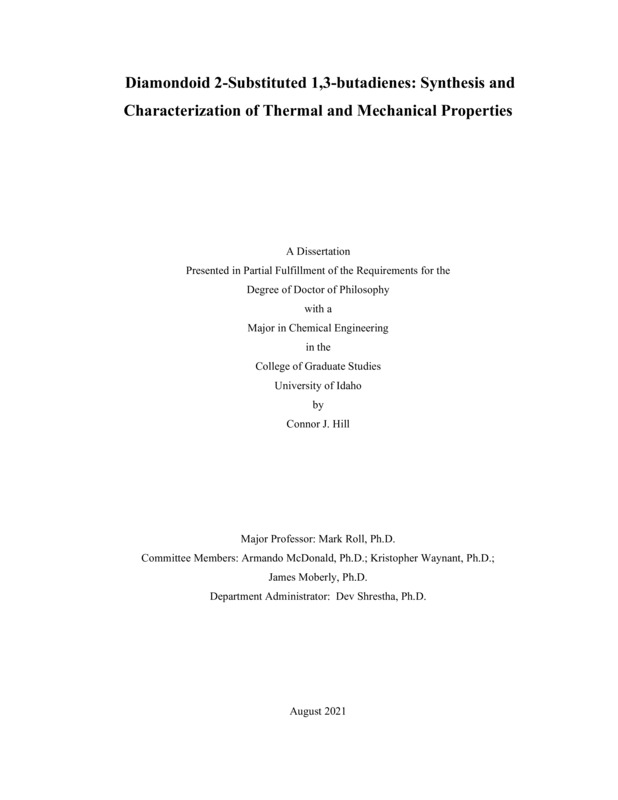Diamondoid 2-Substituted 1,3-butadienes: Synthesis and Characterization of Thermal and Mechanical Properties
Hill, Connor J. (2021-08). Diamondoid 2-Substituted 1,3-butadienes: Synthesis and Characterization of Thermal and Mechanical Properties. Theses and Dissertations Collection, University of Idaho Library Digital Collections. https://www.lib.uidaho.edu/digital/etd/items/hill_idaho_0089e_12175.html
- Title:
- Diamondoid 2-Substituted 1,3-butadienes: Synthesis and Characterization of Thermal and Mechanical Properties
- Author:
- Hill, Connor J
- Date:
- 2021-08
- Keywords:
- adamantane Amberlyst-15 copolymers diamondoids emulsion polymerization polydienes
- Program:
- Chemical and Materials Science Engineering
- Subject Category:
- Chemical engineering
- Abstract:
-
An improved monomer synthesis for diamondoid 2-substituted 1,3-butadienes is presented. Heterogenous dehydration of 2-(1-adamantyl)-3-buten-2-ol using Amberlyst®-15 cationic exchange resin at ambient temperature gave 2-(1-adamantyl)-1,3-butadiene (1) in excellent yield. An improved UV photoacetylation of diamantane was also identified and the dehydration of 2-(4-diamantyl)-3-buten-2-ol afforded 2-(4-diamantyl)-1,3-butadiene (2) in good yields. Overall, heterogeneous dehydration with Amberlyst®-15 presents an attractive monomer synthesis route for diamondoid 2-substituted 1,3-butadienes in quantities necessary for comprehensive polymerization studies.
Emulsion polymerization of 1 and mixtures of 1 and isoprene was carried out at room temperature using redox pair-type hydroperoxide initiator. All poly(1) and poly(1-ran-isoprene) samples were soluble in common organic solvents and exhibited high 1,4-microstructure. A continuous increase in glass transition temperature (Tg) from -63 to 172°C was observed by increasing the ratio of 1 in the comonomer feed of poly(1-ran-isoprene), and Tg values were in good agreement with the Fox equation. After complete hydrogenation to poly(1-vinyladamantane-alt-ethylene-ran-propylene-alt-ethylene) a continuous increase in Tg was observed from -55 to 152°C. The high solubility and improved access to 2-(1-admantyl)-1,3-butadiene open the door for the exploration of diene polymers with enhanced high temperature properties.
The first mechanical characterization of the poly(1) and the rubbery poly(1-ran-isoprene) system is reported here. Bulk samples were hot pressed and analyzed with dynamic mechanical analysis in a 3-point bend geometry. In conjunction with rheometry, a more complete characterization of the glass transition, rubbery plateau, and rubbery flow regions with respect to wt% of 1 was achieved. Rheology of poly(1) before and after complete hydrogenation of the backbone was performed to understand the effect that backbone rigidity has on flow properties.
Nitroxide mediated polymerization was investigated as a potential route for poly(1) block copolymers. However, it was determined that the formation of monoterpene side products was favored at required reaction temperatures. A novel living anionic polymerization technique using 4,5-methylenephenanthrene an indicator to titrate impurities prior to initiation with sec-butyllithium was then used to synthesize poly(1) and poly(1-block-isoprene). A comparison of anionic to emulsion poly(1) prompted an investigation into the insolubility of the former. Powder x-ray diffraction experiments revealed distinct diffraction peaks in anionic poly(1). NMR and GPC analysis suggests the presence of branching in emulsion poly(1) while anionic poly(1) was confirmed to be completely linear. It is hypothesized that branching in emulsion poly(1) contributes its observed solubility.
- Description:
- doctoral, Ph.D., Chemical and Materials Science Engineering -- University of Idaho - College of Graduate Studies, 2021-08
- Major Professor:
- Roll, Mark F
- Committee:
- McDonald, Armando G; Waynant, Kristopher V; Moberly, James G
- Defense Date:
- 2021-08
- Identifier:
- Hill_idaho_0089E_12175
- Type:
- Text
- Format Original:
- Format:
- application/pdf
- Rights:
- In Copyright - Educational Use Permitted. For more information, please contact University of Idaho Library Special Collections and Archives Department at libspec@uidaho.edu.
- Standardized Rights:
- http://rightsstatements.org/vocab/InC-EDU/1.0/

